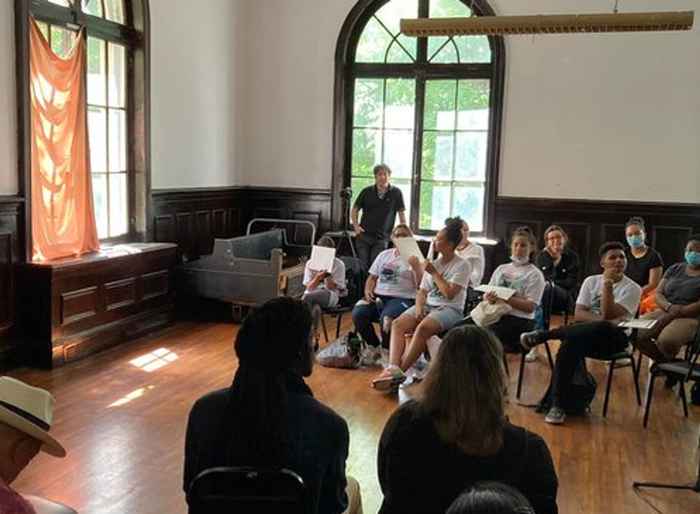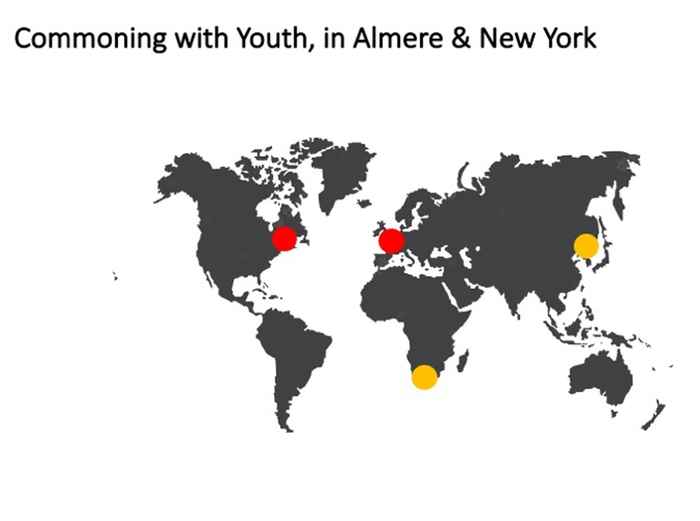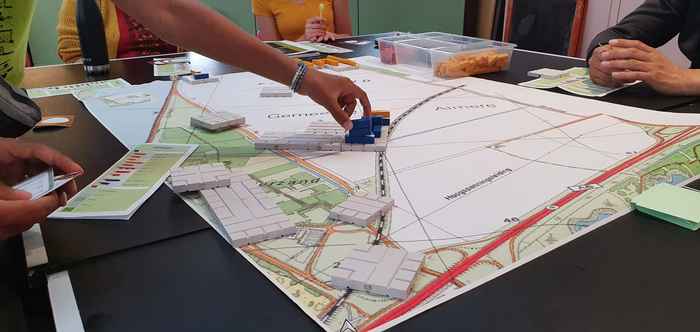Creative Urban Commons with Children and Youth, in Almere Poort, the South Bronx New York, Taipei and Johannesburg
Francesca Ranalli and Jade Mandrake
The CUS project explores children’s perceptions and experiences of the urban commons through ethnographic and artistic research. To this end, the involved children experimented with ways of opening up the public spaces in their neighbourhood to meet their needs and desires. The project started with walk-along discussions to explore the children’s neighborhoods and study their mental maps. It continued with an art workshop where the children expressed their place attachment through drawings and models.
We concluded with a temporary art installation where children designed their own flag and reclaimed a public green space in their neighbouhood. Through object analysis of the videos and children’s drawings, we developed the following lesson learned. The project is in partnership with the Municipality of Almere, four local primary schools and artists.
The project with youth starts with our realization that while children have their own dedicated spaces and playgrounds, teenagers have no apparent right to co-modify public spaces and find their spatial dimension. In the diverse and changing neighbourhoods, this project aims to build an inclusive and equal young community in a safe and hopeful environment. The changing urban areas include peripheries, gentrifying and peri-urban areas, in different international contexts, with the commonality of a diverse young population struggling to find their identity and community role. the first concluded phase involved Almere Poort in the Amsterdam Metropolitan Region, the Netherlands, and the South Bronx, New York, while the second phase includes Taipen, Taiwan and Johannesburg, South Africa. In the first fìphase we developed an open-ended and replicable model for commoning that we are applying in the second phase. the young participants developed a co-creative hub that is locally rooted in their neighbourhood, and globally connected through the platform we developed where the youth podcast will soon be available. For this project, we applied for the Roet Prize, the CUS-CUS-SSGH-UMH grant and local municipal funds within a broader research network as a launching point, reclaim selected spaces, and build the young communities. Future funding will guarantee its maintenance.
The methodology and results with children
The walk-along discussion with children, which combines focus group discussions with participant observation, has the potential to add new layers of understanding about how the participants comprehend and associate meaning to the physical and social environment (Lefebvre, 1991; Kusenbach, 2003). During the walk-along discussions, the children studied the maps, based on Lynch’s method on mental mapping and recollected places in their neighborhoods. This method provided insights on socio-spatial inclusion (how people feel in certain spaces) and shared emotional bonds (how they map their common areas, where they meet or prefer to go). Furthermore, the walk-along discussions resulted in a learning process for the children and helped them to open up to the following discussions in the art workshop and for the production of drawings and models.
The whole process was video- and voice-recorded. The analysis of the recordings, drawings and models was conducted using object analysis in the mode of the Amsterdam School for Cultural Analysis (ASCA). Following the non/rational research method described earlier, we assign epistemic authority to the object through close-reading and a commitment to the interdisciplinarity that the objects evoke. While our role is not assumed to be entirely neutral, working in this mode meant co-creating with the object based on its own terms, and resisting a predetermined theoretical or conceptual compass (Bal, 1999). From the perspective of artistic research, we engaged the whole artistic process as objects producing knowledge together with scholarly work.
The children’s drawings and filmed walk-along discussions evoked a number of insights. Among them:
- The children presented a strong spatial awareness: As largely unstructured explorations, the walkalong discussions revealed the acuteness of the children’s perceptiveness and interest; eg locating areas of safety, fun, and play vs. boredom and danger; awareness of changes made by the municipality, such as buildings vs. green areas.
- The majority displayed a high degree of emotionality in their perceptions, including strong opinions and a general enthusiasm of their spatial awareness indicating attachment to place (Florek 2011).
- We saw that by involving them in these activities, the children learned to recognize their own spatial awareness and acute felt-perceptions as tools.
- The majority of children appeared constricted in their creativity when sketching ideas for urban spaces; the children explored within the already-established repertoire of urban planning, rearranging, adding or subtracting common elements. Eg, requests for skate parks were frequent, while other children tended towards spaces of encounter that were more inclusive but less specific. A minority of drawings incorporated imaginative play in the urban space (what we would call differentiated ideas), for example, the drawing in which a student revealed a personified building (shown below).
- We are exploring why the children emphasized rational approaches to the spaces in the art workshops; these include psychosocial development factors, the school setting, the researchers’ outsider group status, the experience of being filmed, the task of spatial design.
The methodology and results with teens

We noticed a substantial difference between the younger groups (8 to 10 years old) and the older ones (11 to 12 years old), as those two age groups showed different interests in the places that they prefer, and their desires for the neighbourhoods. In general, the younger ones were more satisfied in the existing playgrounds and also more attached to their homes, while the older groups expressed the need for more diverse spaces of encounter. Furthermore, learning from the analysis for the following international project, we will emphasize imaginative play that lends to unconscious symbolic expression (eg, dreams, myth, story-telling) in order to foster individual, creative expressions alongside the rational work of spatial planning. In doing so, individual expression and meaning-making is thought with the collective, and its relation to agency and inclusivity (Morgan 2010). In this framework, we involved young people in the age range of 13-17 years old to develop a bottom-up model of commoning. Currently, the group in Almere Poort aims to develop a space like a hub where they can experiment with music, and share experience with their peers in the South Bronx. For this reason, we developed an instagram platform that we call HUB (Hacking Urban Boundaries).

